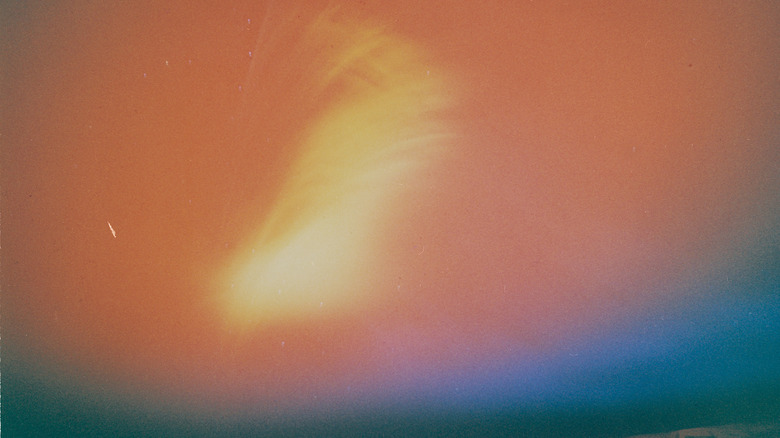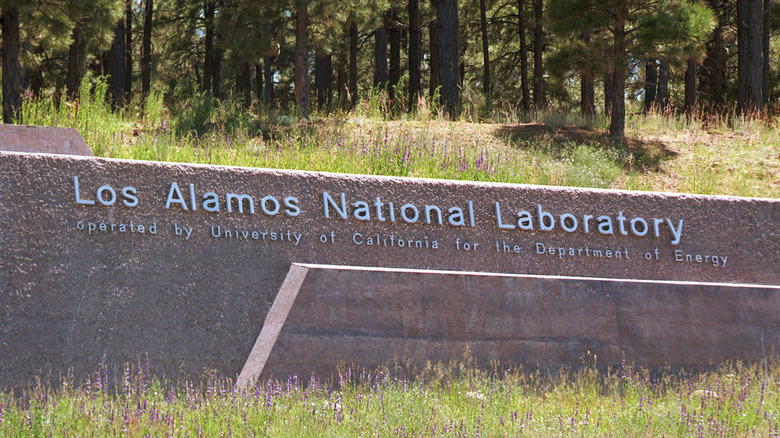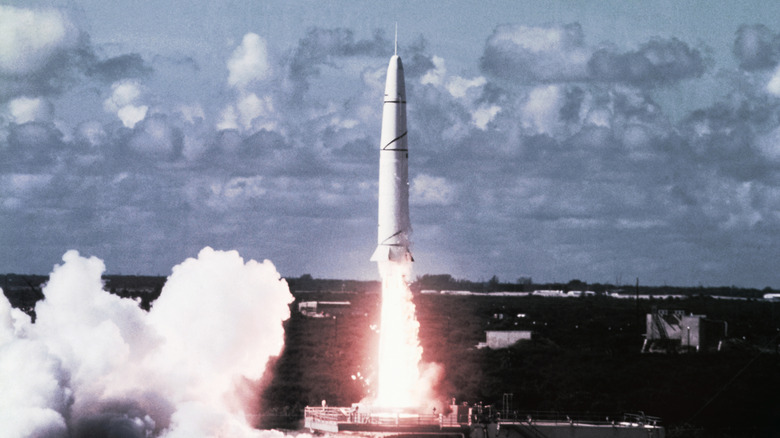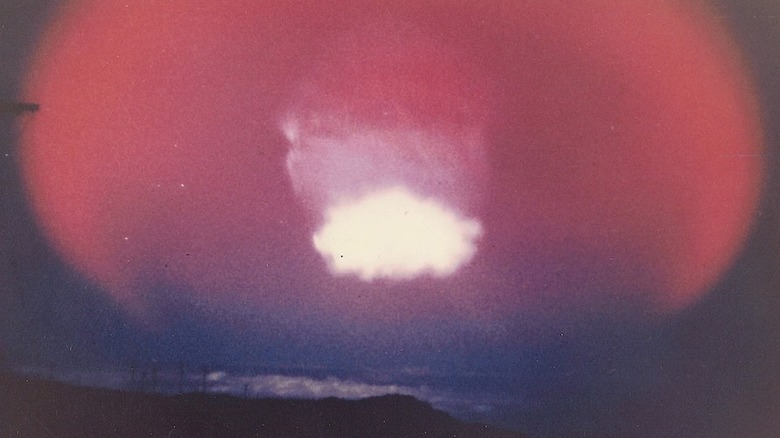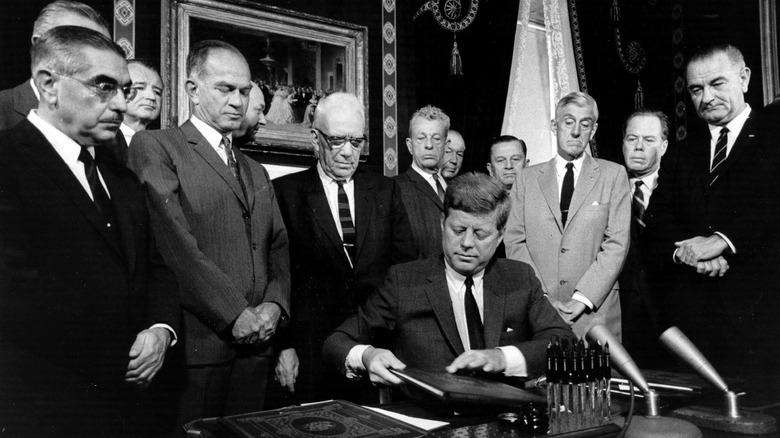What Happens When A Nuclear Bomb Detonates In Space?
As unfortunate as it is, atomic weapons have been a part of the public conversation since their existence was revealed to the public after the United States dropped two atomic bombs on the Japanese cities of Hiroshima and Nagasaki. Though it forced the last remaining Axis forces to surrender in 1945, it came at a cost.
With the effects of nuclear weapons on the ground are unfortunately very well documented, it's worth asking what would happen if a nuclear weapon was detonated in space or just inside the atmosphere? It seems fairly far-fetched, as the concept was a plot point in the 2009 video game "Call of Duty: Modern Warfare 2," when a nuclear missile launched by a Russian submarine detonated above Washington D.C. Despite the rest of the plot being mostly blockbuster nonsense, nuclear weapons have actually been detonated in space in real life.
A nuclear weapon test, dubbed "Starfish Prime," was conducted on July 9, 1962, by the Los Alamos National Laboratory. The team aimed to see what would happen if a 1.45 megaton nuclear bomb was detonated 250 miles above the Pacific Ocean. For reference, a 1.45 megaton bomb has roughly 100 times more power than the Hiroshima bomb.
A light show, followed by a blackout
From a visual perspective, the explosion was reportedly a sight to behold, as it looked like the Aurora Borealis was happening over Hawaii. For thousands of miles, spectators could see flashes of red, green, or blue streaks across the sky for about half an hour, according to the Smithsonian Magazine.
After it exploded, the hydrogen bomb let off an electromagnetic pulse that fried electronic devices and knocked out power 1,000 miles away in Hawaii. Additionally, Telstar — the very first communications satellite for AT&T — was damaged by residual radiation a day after the launch, and eventually knocked out of commission by later nuclear tests.
Nuclear researchers learned first hand that even if a nuclear weapon doesn't hit a target directly, or go off in an airburst, it's still incredibly dangerous even as it explodes a few hundred miles up in the sky. Both the Soviet Union and the United States needed to tread lightly if testing were to ever happen again.
The launch vehicle
The launch vehicle for the nuclear payload was a Thor intermediate range ballistic missile, developed by Douglas. The missile is a single-stage rocket capable of producing 150,000 pounds of thrust from its main rocket engine. For comparison, the Lockheed F-104C — a record breaking fighter jet from the same era — only made 15,800 pounds of thrust. Interestingly enough, after the nuclear tests, the Thor missile system took on a more peaceful role for NASA as a space launch vehicle. During the test, the Thor missile was only in the air for less than a minute before launching its payload.
The Starfish Prime test may have been the highest altitude nuclear weapons test, but it wasn't the first time the United States sent nuclear missiles into the sky to record what happened when their nuclear payload went off. Earlier, in 1958, Operation Hardtack I would see the detonation of not one, but two nuclear weapons at high altitudes.
Other high altitude tests
The first test, named "Teak," was the launch of a Redstone missile that detonated its 3.8 megaton payload at an altitude of 50 miles. That's high, but not quite the altitude to be considered space. "Orange" was the second test that used the same payload and missile: Instead of 50 miles, Orange went off at 25 miles up. According to Rear Admiral Daniel W. McKinnon Jr., a U.S. Navy officer who was present at the tests, the blast was so bright that it appeared to be daytime at the moment the nuclear bombs went off. Sailors and soldiers attending the test were warned that the flash from the nuclear explosion could seriously damage their eyes and potentially burn their skin if they weren't careful with precautions.
The Redstone missile used during the Hardtack tests was the first ballistic missiles used by the United States, and was developed using technology first pioneered by Nazi scientists like Wernher Von Braun. Braun was present at the Hardtack tests that used the Redstone launch vehicle.
Nuclear weapons testing bans
The Starfish Prime and Hardtack tests were successful inasmuch as both the Soviet Union and the United States realized they shouldn't amp up the tonnage and do it again. The Limited Nuclear Test Ban Treaty signed by John F. Kennedy in 1963 banned high altitude tests like Starfish Prime from happening again.
While it could be argued that American nuclear weapon tests advanced nuclear science and helped develop tactics to lessen the effects of a nuclear blast, it's inarguable that nuclear weapons testing — in space or on the ground — isn't something that should happen with much regularity, at least with the United States pressing the button. In fact, the United States hasn't tested a nuclear weapon since 1992. Nations like North Korea still occasionally test nuclear weapons, but it's unlikely that North Korea would gamble with a test like Starfish Prime, or even Hardtack.
If a larger bomb were ever set off in space, as unlikely as that is, one could imagine that the resulting technological toll would be extremely heavy, as power would likely be disrupted over a large portion of the landmass below detonation. With the cessation of the Cold War and the collapse of the Soviet Union, the risk of all out nuclear war has dropped precipitously, allowing for at least a measure of ease regarding the possibility of such an airborne attack.
